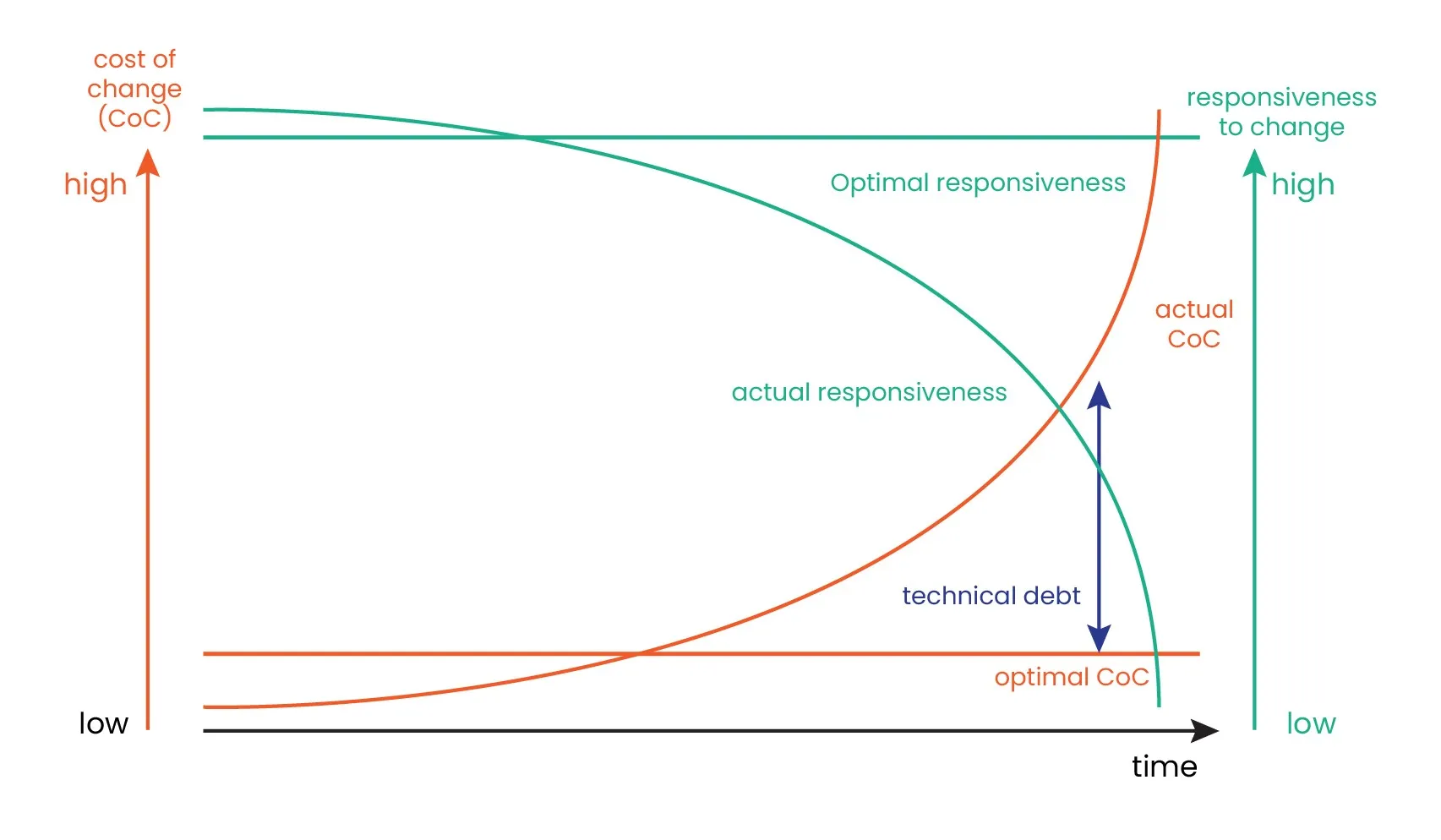Tackling technical debt: A guide to low-code application development
Blog: Indium Software - Big Data
You may be caught in the tech debt spiral

In today’s fast-paced digital landscape, businesses turn to low-code application development to build and deploy software solutions quickly. Low-code platforms offer a visual development environment that accelerates the development process, allowing businesses to deliver applications to market faster than ever before. However, like any development approach, low-code development is not immune to technical debt—an accumulation of suboptimal code or design decisions that can hinder an application’s scalability, maintainability, and performance over time.
According to a recent McKinsey study, “Companies that spend a significant portion of their IT budget on legacy system maintenance and integrations can be caught in a tech debt spiral. This is because they are constantly paying interest on their technical debt, which prevents them from investing in new offerings. Conversely, companies with a modern IT infrastructure have very minimal or no tech debt and invest in new offerings. Most of the companies fall between these two extremes”.
| Company | IT budget allocation | Ability to invest in new offerings |
| Tech debt spiral | 50% on integrations and legacy system maintenance | Low |
| Modern IT stack | <50% on integrations and legacy system maintenance | High |
| In between | 50–50% on integrations and legacy system maintenance | Medium |
border: 1px solid #000;
}
Don’t let technical debt slow you down in low-code app development! Learn the top ten proven strategies to mitigate debt and supercharge your projects!
Cheat sheet—coming soon!

Technical debt is the cost of future rework incurred by taking a quick and easy solution rather than choosing a better approach that consumes time. It is anything that makes it more difficult to change or maintain software in the future. Technical debt can have a significant impact on the long-term success of a software project. It can make it more difficult to add new features, fix bugs, or make changes to the software. It can also lead to increased costs and delays. It is important to manage technical debt effectively—regularly assess the codebase for potential problems and take steps to address them before they become too serious.
For example, consider a developer who creates an application that works on two different databases but decides to use only one for the time being as it is simpler to manage. When a requirement surfaces to integrate the app with another database, the developer may realize that the data needs to be synced to both databases simultaneously. This can be a difficult and time-consuming task, and it may require the developer to make significant changes to the application’s code.
In this case, the developer’s decision to use just one database has created technical debt because it has made it more difficult to integrate the application with another app. This can lead to delays in the development process, and it could also make the application more difficult to maintain and update in the future.
Technical debt is the cost incurred when shortcuts are taken in the development process. These shortcuts may seem like a good idea at the time, but they can lead to problems in the future. To avoid technical debt, it is important to carefully consider the long-term implications of decisions made during the development process. It is also important to be aware of the potential costs of shortcuts and to weigh these costs against the benefits.
Just like financial debt, technical debt mounts up over time and requires repayment in the form of additional work and effort to address issues and improve the application’s quality.

How does technical debt occur in low-code application development?
In low-code application development, technical debt may arise due to various reasons, including:
Shortcut solutions: To speed up development, developers may opt for quick solutions that may not be the most efficient or scalable in the long run.
Incomplete testing: Rushing through testing phases can lead to undiscovered bugs or potential security vulnerabilities.
Poor documentation: Incomplete or insufficient documentation can make it challenging to understand the application’s intricacies, leading to future issues.
Lack of scalability planning: Failing to plan for the application’s scalability from the beginning can result in costly rework later on.
One common way that technical debt accumulates is when developers do not follow design standards or coding best practices. This can make the code more difficult to read, understand, and maintain. As a result, subsequent developers will need to put in more effort to optimize the codebase. This can lead to several negative consequences, including:
Slow down team velocity: It can take longer for developers to complete tasks, which can slow down the development process.
Decelerate time to market: It can take longer to release new features, which can make it difficult to keep up with the competition.
High risk of bugs: The code may be more prone to errors, which can lead to downtime and other problems.
Increased debugging difficulty: It could be more difficult to track and fix bugs, which can lead to further problems.

To avoid technical debt, it is important to carefully consider the long-term implications of any decision made during the development process. It is also important to follow design standards and optimize code whenever possible.
Top ten tips to crush technical debt and enhance performance. To start your debt-free journey, stay tuned to check out our cheat sheet!
Low code platforms help reduce technical debt—How?
Low-code development can help reduce technical debt by:
Automating repetitive tasks: It reduces the risk of human error and speeds up development time.
Providing a visual interface: This makes it easier for non-technical users to create and modify applications, which can help reduce the complexity of the codebase.
Reusing components: It helps to avoid duplication of code and makes it easier to maintain the application.
Enabling rapid prototyping: This allows developers to quickly create and test new minimum viable or minimum marketable products (MVP/MMP), which are likely to be modified based on the customer’s long-term IT infrastructure strategies.
Providing version control and testing tools: It helps to ensure that changes to the application are made in a controlled and tested manner, which can help to prevent technical debt from accumulating.
In addition to these benefits, low-code development can also help reduce the cost of software development and improve the overall quality of the application.
Now that we understand the challenges of technical debt in low-code development, let’s explore the top five ways to mitigate it effectively:
Top five ways to mitigate technical debt in low-code application development

Solution architecture
To reduce technical debt in low code app development, it is important to define robust security standards, build a well-designed domain model, implement seamless integration, and optimize performance. Make sure that developers are familiar with the best practices for low-code solutions development, and regularly review the application for technical debt and create strategies to address it.
Pre-built/reusable components
Reusable components are a way to reduce technical debt by reusing code that has already been tested and debugged. This can save time and effort, and it can also help improve the consistency of your code by ensuring that all your components are using the same standards and conventions.
Code quality and review
Code reviews help identify and fix bugs before they are released into production. This can save time and money in the long run. Code reviews also identify security vulnerabilities and performance issues and make recommendations for improvement. This can prevent technical debt from accumulating and causing problems in the future.
Best coding standards
By adopting best coding practices, developers can build high-quality software that is easy to maintain and evolve. When they stay informed about the latest developments in low-code technology, developers can reduce the risk of technical debt and ensure that their software is reliable and efficient.
Technical debt management strategy
The most crucial technical debt issues should be included in this strategy, and they should be given the appropriate level of priority. Keep tabs on how technical debt is being resolved, and make it a part of your company’s culture to address it in a timely manner.
Are you a Mendix user? Don’t let technical debt hold you back! Unleash the power of Mendix for enhanced CX and streamlined app development.
Partner with Indium Software
Low-code application development has revolutionized the speed at which software applications are built and deployed. However, the rapid development process can lead to technical debt if not managed properly. We understand that mitigating technical debt in low-code solutions is vital for ensuring the long-term success and maintainability of software solutions. That is why we have established a Center of Excellence (CoE) for low code platforms that enable our clients to effectively handle technical debts by defining a clear development strategy, conducting regular code reviews, and planning for scalability. With this proactive approach to technical debt, businesses can ensure their low-code applications are robust, maintainable, and capable of adapting to future needs, providing a competitive advantage in the dynamic digital landscape.
Finally
Technical debt is a common challenge in low-code application development, but with careful planning and implementation, it can be effectively mitigated. Businesses can build robust and future-ready low-code applications by emphasizing code quality, comprehensive testing, scalability planning, and documentation. Additionally, being vigilant about identifying and managing technical debt throughout the development lifecycle is crucial to ensure that the application remains maintainable and adaptable as business needs evolve. By taking these steps, organizations can maximize the benefits of low-code development while minimizing the risk of technical debt, leading to more successful and sustainable software solutions.
Discover the top ten ways to slash technical debt in low-code app development and build a future-proof software ecosystem!
Get ready for the cheat sheet.
The post Tackling technical debt: A guide to low-code application development appeared first on IndiumSoftware.